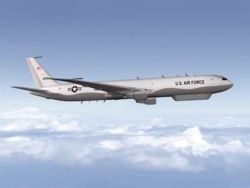PlaneSpottingWorld welcomes all new members! Please gives your ideas at the Terminal.
E-10 MC2A
The Northrop Grumman E-10 MC2A was planned as a multi-role military aircraft to replace the Boeing 707 based E-3 Sentry, E-8 Joint STARS, and RC-135 Rivet Joint aircraft in US service. It was based on the 767-400ER commercial airplane.
Contents
Development
In 2003, the Northrop Grumman, Boeing, and Raytheon MC2A Team was awarded a $215 million pre-SDD (System Development and Demonstration) contract for the development of the aircraft.
While the Northrop Grumman E-8 Joint STARS aircraft are a recent development, they will be the last such type to be based on the 707. To install the high technology systems envisaged for the MC2A on an increasingly obsolete airframe would not provide the capability required. The availability of powerful and reliable turbofans allowed a twinjet to be considered.
MC2A stands for Multi-Sensor Command and Control Aircraft. The MC2A was intended to be the ultimate theater-wide combat control center.
In August 2003 Air International reported that the goal of integrating air- and ground-search radars on a single airframe was abandoned. Electronic interference between the AESA and ground-surveillance radars as well as the power requirements for both systems were cited as the reason. Instead the USAF decided to plan two separate E-10 fleets to be integrated with the proposed Space-Based Radar system, air and space-based ELINT/SIGINT assets, and space-based IMINT satellites. It would have been the central command authority for all air, land, and sea forces in a combat theater. The E-10 was also considered for use as a command center for unmanned combat air vehicles.
The capability of the MC2A was to be raised incrementally, with each phase known as a "spiral."
- Spiral 1 - Multi-Platform Radar Technology Insertion Program (MP-RTIP)
This version would have provided substantial Joint Cruise Missile Defense (CMD) capability with focused AMTI modes and augment the E-8 Joint STARS in the ground surveillance role. - Spiral 2 - AWACS Capability
This version would have replaced the E-3. It was expected that the Spiral 2 version would use a variant of the Boeing Wedgetail's Multi-role Electronically Scanned Array. - Spiral 3 - SIGINT Platform
This version was intended to replace a wide range of SIGINT/ELINT aircraft. No plans existed to develop this version.
Scale-back
In January 2006, the Air Force FY07 budget request revealed a reshaping of the E-10 program, with the cancellation of the E-10A SDD program, but maintained funding for the development and testing of a single demonstration aircraft, now known as the E-10A Technology Development Program (TDP).[1] The TDP would flight test the MP-RTIP Wide-Area Surveillance (WAS) radar, and conduct flight demonstrations of the E-10A's Cruise Missile Defense (CMD) Capability. The SDD elimination was designed to be a cost cutting measure and part of a larger reorganization and redefinition of the Air Force's mission including the retirement of the E-4B and F-117 fleets, as well as the elimination of all but 58 B-52s.
Cancellation
The E-10 finally disappeared at the end of FY2007 as budget pressures and competing priorities pushed it completely out of the budget. The USAF maintained funding for the MP-RTIP radar and may eventually put the radar on the E-8, or on a new aircraft, possibly the same airframe as the next aerial tanker.[2] The smaller version of the MP-RTIP AESA radar designed to be flown on the RQ-4B Global Hawk is being flight tested on the Scaled Composites Proteus aircraft. Boeing had kept the E-10 prototype (767-400ER) at Paine Field in Everett, Washington, until the prototype was sold to Bahrain in January 2009 for conversion into a VIP transport.[3]
Specifications (767-400ER)
Data from B767-400ER[4]
General characteristics
- Crew: 2
- Length: 201 ft 4 in (61.3 m)
- Wingspan: 170 ft 4 in (51.9 m)
- Height: 55 ft 4 in (16.8 m)
- Empty weight: 229,000 lb (103,872 kg)
- Max takeoff weight: 450,000 lb (204,116 kg)
- Powerplant: 2× P&W PW4000-94 or GE CF6-80C turbofan, PW: 63,300 lbf or GE: 63,500 lbf (PW: 281.6 kN or GE: 282.5 kN) each
Performance
- Maximum speed: Mach 0.86 (568 mph, 913 km/h)
- Cruise speed: Mach 0.80 (530 mph, 851 km/h)
- Range: 5,600 nmi (10,370 km)
- Service ceiling: 40,100 ft (12,200 m)
References
- ↑ "Boeing Polishes 737 Design For EP-3 Replacement : Mixed Signals." Fulghum, D. A. and Wall, R. Aviation Week & Space Technology. January 29, 2006.
- ↑ Tirpak, John A. "The big squeeze", Air Force Magazine. October 2007.
- ↑ Sarsfield, Kate. "Bahrain acquires 767-400ER testbed for VIP use". Flight International, 27 January 2009.
- ↑ Boeing 767-400ER Technical Characteristics
External links
Related content
Related development
Comparable aircraft
Designation sequence
- E-7 - E-8 Joint STARS - E-9 - E-10 MC2A
Lists relating to aviation | |
|---|---|
| General | Timeline of aviation · Aircraft · Aircraft manufacturers · Aircraft engines · Aircraft engine manufacturers · Airports · Airlines |
| Military | Air forces · Aircraft weapons · Missiles · Unmanned aerial vehicles (UAVs) · Experimental aircraft |
| Notable incidents and accidents | Military aviation · Airliners · General aviation · Famous aviation-related deaths |
| Records | Flight airspeed record · Flight distance record · Flight altitude record · Flight endurance record · Most produced aircraft |

